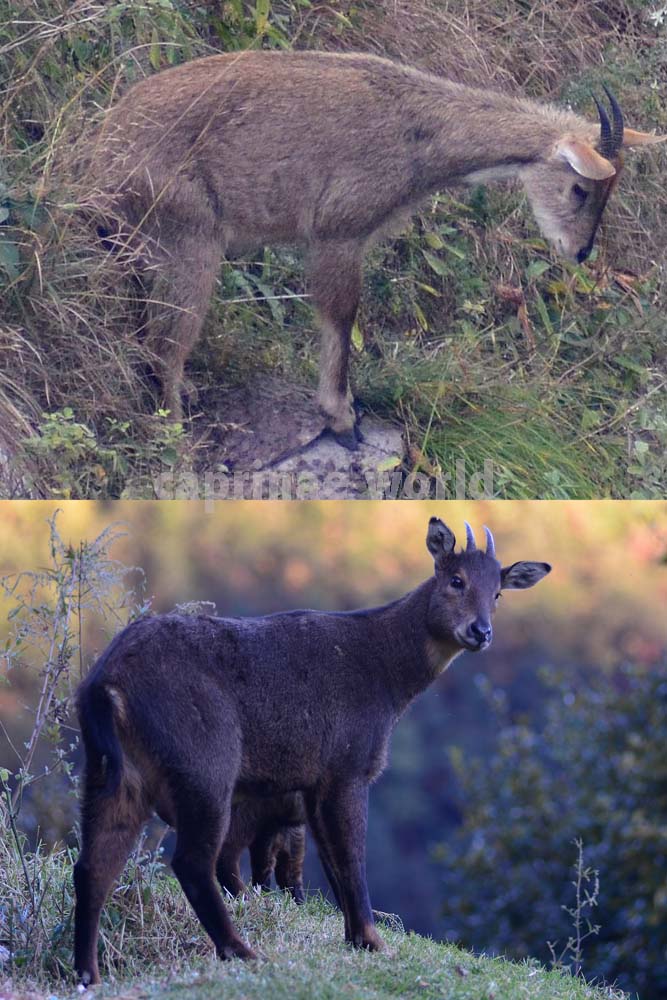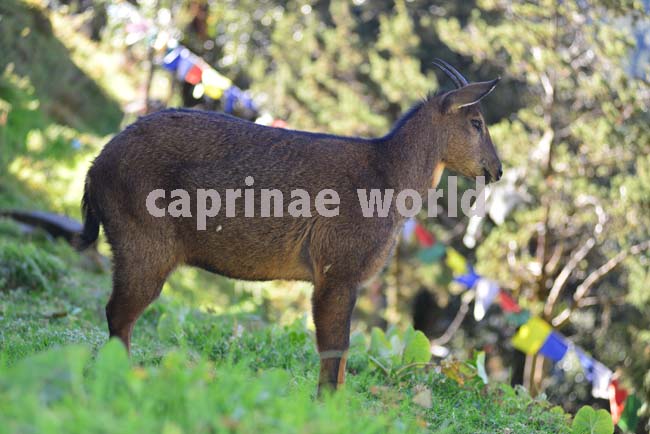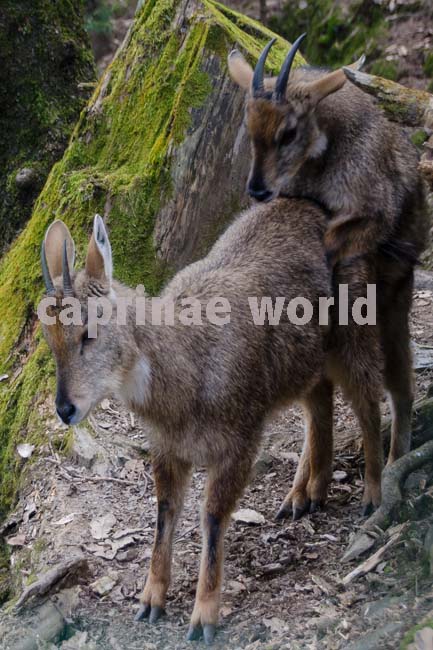The „Himalayan goral“ is actually two species which inhabit almost the entire west-to-east extension of the Himalayas. They occur as a westerly and an easterly form.
Names / Taxonomy
Chinese: 斑羚 [wikipedia]
English common name: Himalayan Goral
French: Goral de Himalaya [1]
German: Himalaya Goral [1]
Kashmiri: ghooral, rome [1]
Russian: гималайский горал [1]
Sikkim Bhotia: ra giyu [1]
Spanish: Goral del Himalaya [1]
It has long been debated whether the Himalayan Goral should be classified as one species Nemorhaedus goral with two subspecies Nemorhaedus goral bedfordi and Nemorhaedus goral goral [1, 2] or as two species Nemorhaedus bedfordi and Nemorhaedus goral. [3, 4, 5].
Hrabina (2015) presented detailed descriptions of pelage features of all the extant taxa, including the Himalayan Gorals, and defined determination features, which help to identify the species. He writes: „The most significant differences can be seen in the winter coat, where the Himalayan Grey Goral remains quite light in colour, while the East Himalayan species conspicuously darkens. Other differences can be found in the presence of or absence of dark stripes on the head and body, and also in the character of the tail colouring. These characters are so conclusive that it is virtually impossible to confuse them.“
Hrabina (2015) also suggests a name change for the two Himalayan Goral species: Formerly the scientific name of the Western Himalayan Goral was Nemorhaedus bedfordi or Nemorhaedus goral bedfordi respectively, and the name for the Eastern Himalayan Goral was Nemorhaedus goral or Nemorhaedus goral goral respectively. According to Hrabina the name Nemorhaedus goral should be borne by the Western Himalayan Goral species, while the Eastern Himalayan species should be referred to as Nemorhaedus hodgsoni.
The reason that led Hrabina (2015) to change the names of the Himalayan Gorals follow the rules of taxonomy. Hrabina (pers. comm.) explains:
„All scientific names are fixed on type specimens defined by scientists who have described the species in their original work. The localities of origin of these specimens are called type localities. The following names are available for the Himalayan species:
N. bedfordi – locality type: Dharamshala, Himachal Pradesh, India
N. goral – locality type: Kathmandu, Central Nepal
N. hodgsoni – locality type: Sikkim, India
Groves and Grubb (2011) delimited the distribution boundary between those species by the Sutlej River (Himachal Pradesh). Westward of this river, according to this hypothesis, lives the Himalayan Gray Goral, eastwards lives the Himalayan Brown Goral. From this point of view, in the area of the Himalayan Gray Goral lies only Dharamshala – the type locality of bedfordi. The names N. goral and N. hodgsoni then fall within the distribution limit of the Himalayan Brown Goral.
On the contrary, I conclude that the boundary between the two species lies east of Kathmandu. The specimens from Kathmandu are typical representatives of the Himalayan Gray Goral. In this regard, individuals from Dharamshala and Kathmandu fall within the range of the grey species. The name N. goral has priority over the name bedfordi, it becomes a junior synonym of the species N. goral. For this reason the name hodgsoni with the type locality in Sikkim must be applied for the Himalayan Brown Goral.“ (For this topic see also next entry.)
Distribution
by country: Buthan, China (Xizang), India, Nepal, Pakistan
It has been a subject of debate, where to set the distribution boundary between the Himalayan Goral species: Wilson and Mittermeier (2011) and Groves and Grubb (2011) state that Sutlej River (in Himachal Pradesh, Northwest India) is the probable distributional boundary between the Himalyan Brown Goral and the Himalayan Gray Goral. [3, 4] However Johnsingh has documented Himalayan Gray Goral from Rajaji NP, Uttarakhand [1], which is about 180 kilometers east of the Sutlej water gap. Ward (1925) placed the boundary between the gray and brown gorals again further east, at roughly the Sarday River [5] – the western boundary of India and Nepal. And Damm and Franco (2014) assume that the gray and brown phenotypes are intergrading in cetral Nepal. [1] This assumption could be based on Pocock (1910), who wrote that both gray and brown goral occur in Nepal, but Groves and Grubb (2011) see no evidence for this. [4] Eventually Hrabina (2015) could unveil that both species indeed integrate in Nepal, east of Kathmandu [8].
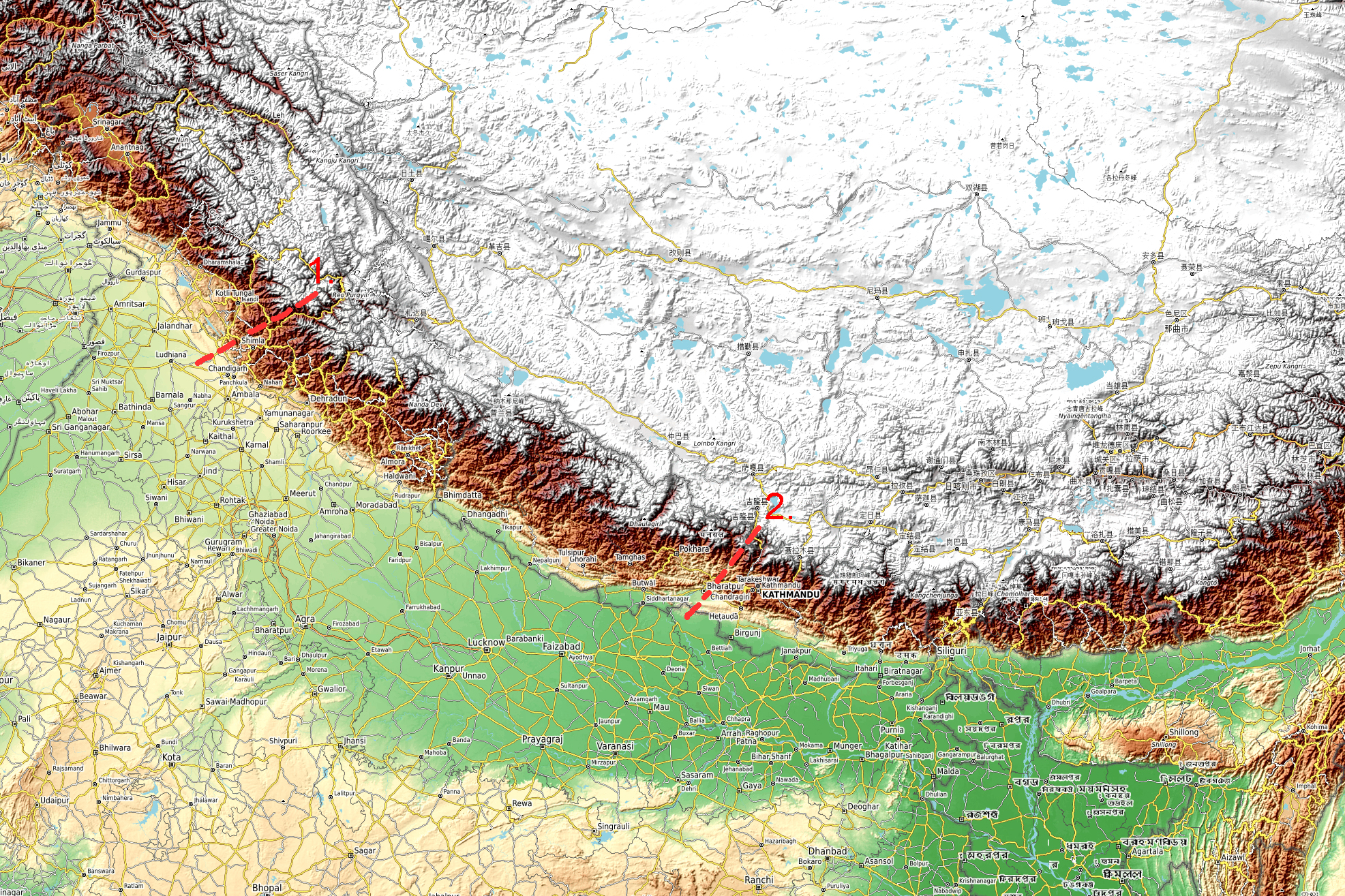
Distribution boundaries between Himalayan Gray Goral and Himalayan Brown Goral: Groves and Grubb (2011) initially draw the line along the Sutlej River (1); Then Hrabina (2015) unveiled evidences for a distribution boundary East of Kathmandu (2.) Map base: OpenTopoMap
The discussion about the distribution boundaries of the Himalayan Brown Goral and the Red Goral, which inhabits the far eastern spurs of the Himalayas, has hardly started yet. [1]
General discription
Measurements for Himalayan Gray Goral were not available. But it can be assumed that body and horn measurements of the Himalayan Gray Goral are in general similar to the Himalayan Brown Goral. [3]
length / head-body: 82-120 cm [3]
weight: 35-42 kg [1, 3]
horn length (males): 15-23,5 cm [3]
Colouration / pelage
Body colour of Himalayan Gray Goral: often grayish, ranging from gray-brown to yellowish-gray [3]
Body colour of Himalayan Brown Goral: medium brown with black tipped hairs, or gray-brown to pale or dark fawn [4] or golden or rufous brown specked with black and gray [1].
Groves and Grubb (2011) write: „The evidence of the museum skins, which are of both sexes and from different seasons, does indicate a consistent difference between West (mainly Kashmir) and East Himalayan Goral. … Their taxonomic seperation depends on pelage characters …, which is consistent in our material.“ [4] Eventually Hrabina (2015) clarifies the differences (see Table 1). [8]
Table 1: Identification features in pelage colour and patterns among the Himalayan gorals (adapted from Hrabina, 2015)
| Himalayan Gray Goral | Himalayan Brown Goral | |
| summer coat – colour | light reddish grey-brown | light brown |
| winter coat – colour | almost identical to the summer coat, paler grey tones – giving an overall lighter appearance | dark brown to black, noticeably darker compared to summer coat |
| white throat patch | large – from lower lip to half the length of the neck | small – from half the length of the interramal (line between back-end of mandibles) to one third of the neck |
| white throat patch laterally extends onto cheeks | yes | no |
| colour of chin | always white | brown often with black patch; less frequently cream without black patch |
| dark nasal stripe | prominent, rarely absent | absent |
| auricle (outer ear): white patch at the base | prominent | absent |
| dark nape stripe | typycally absent | prominent |
| dark dorsal stripe | absent | prominent |
| thoracic limbs (front legs): dark stripe on dorsal area (front side) | prominent – from radiocarpal joints down to the fetlocks, rarely absent, dark stripes on the thoracic limbs always more dominant | variable – from elbows or radiocarpal joints down to the fetlocks, often in segments |
| pelvic limbs (hind legs): dark stripe on the plantar area (sole) | absent or in segments | prominent – often extends all the way from thighs to fetlocks, dark stripes on the pelvic limbs always more dominant |
| tail colour | the same as the body, only dark tip | all black |
Some examples
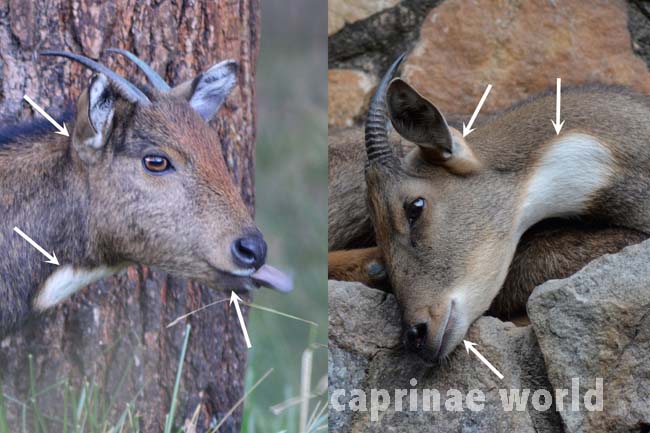
Himalayan Brown Goral, HBG (left); Himalayan Gray Goral, HGG (right). Both in winter coat. Note: throat patch in HGG is bigger; colour of chin in HBG with dark patch; chin of HGG white; base of ear in HGG is white. Photos: Ralf Bürglin
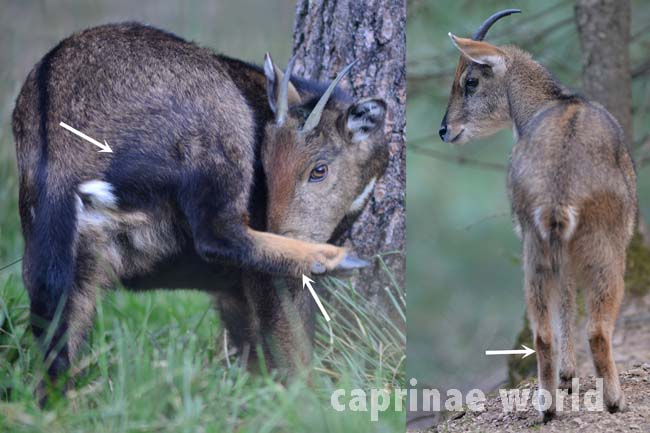
Himalayan Brown Goral, HBG (left); Himalayan Gray Goral, HGG (right). Both in winter coat. Note: in HBG dark stripe on back of hind legs prominent, extending all the way from thighs to fetlocks; in HGG dark strips on back of hind legs are in segments or – like in this specimen – absent. Photos: Ralf Bürglin
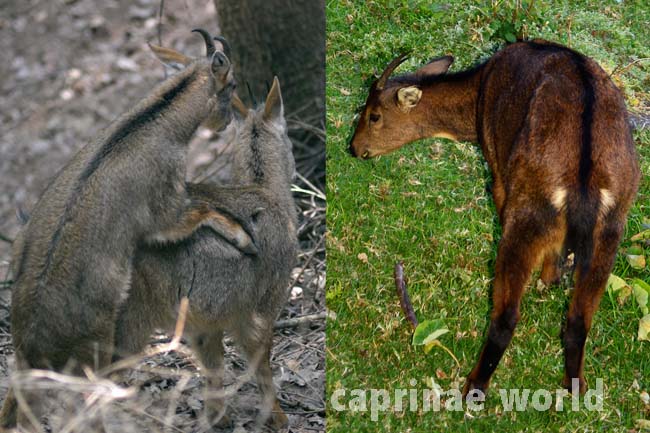
Himalayan Gray Goral, HGG (left), Himalayan Brown Goral (right). Both in winter coat. Note: dark dorsal stripe in HGG is absent or indistinct. Often HGG is also without dark nape stripe. In HBG nape and dorsal stripes are prominent. Photos: Ralf Bürglin
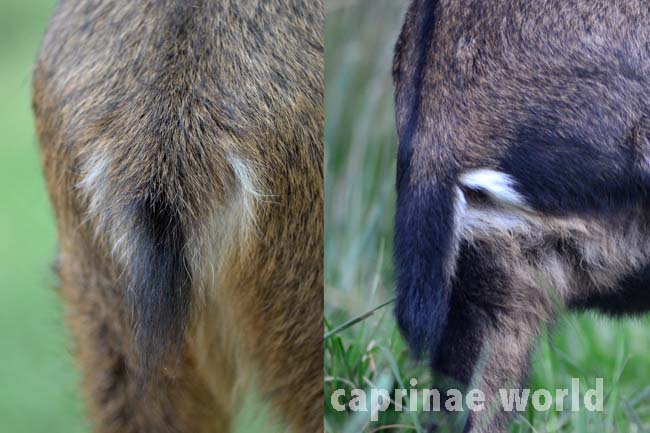
In Himalayan Gray Goral (left) only the tip of the tail is black. Again dorsal line is missing. Tail colour in Himalayan Brown Goral (right) is all black. Photos: Ralf Bürglin
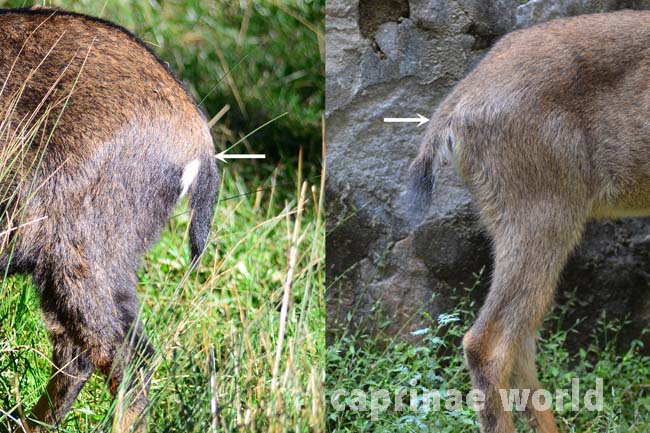
… lateral view of tails: Himalayan Brown Goral (left). Arrows indicate approximate insertion point of tail. Photos: Ralf Bürglin
Is there a Spatial cline in Himalayan goral pelage colour?
As a matter of fact precipitation changes alongside the Himalayas. One can observe that during July the West is considerably drier compared to the East, which in turn affects plant communities.
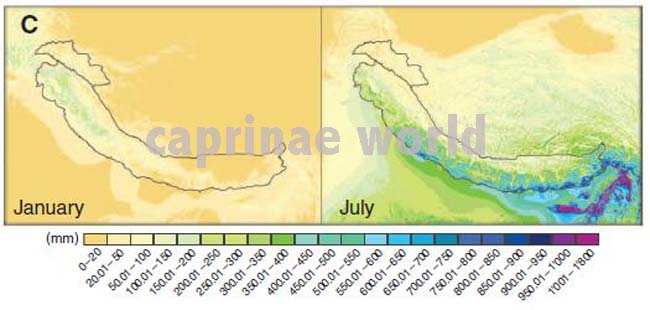
Distribution of precipitation alongside the Himalayas: During summer precipitation increases toward the east. [6]
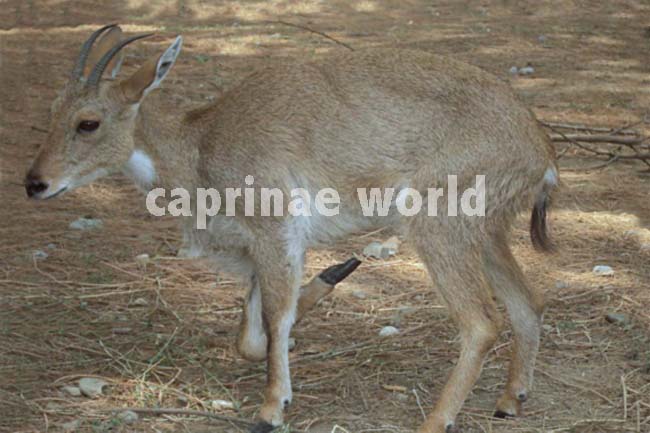
Himalayan Gray Goral from Pakistan. Photo taken at the Pheasantry near Hazara University [7], Mansehra, by Dr. Farzana Khan Perveen
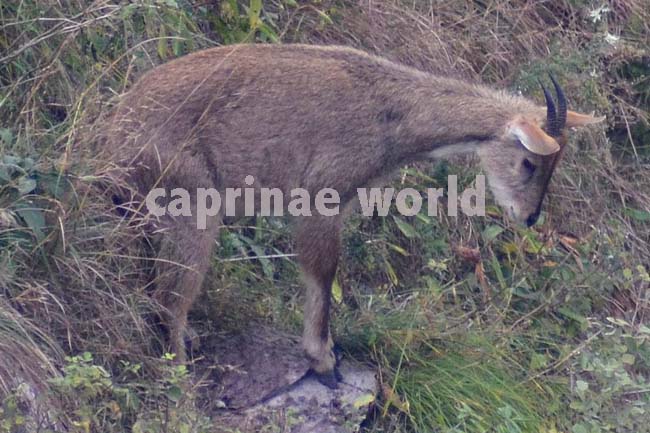
Male Himalayan Goral in winter coat at Majathal Sanctuary, Himachal Pradesh, India – about 500 km southeast of the westernmost distribution area in Pakistan. Note some of the identification features for the Himalayan Gray Goral: large throat patch – extending from lower lip to half the length of the neck and onto the cheeks; white chin; dark nasal stripe, white patch at the base of auricle (ear), dark nuchal and dorsal stripe absent [8]. Photo: Ralf Bürglin
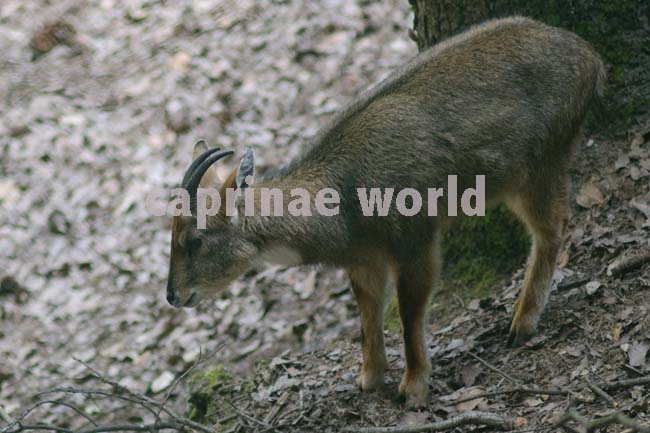
Male Himalayan Gray Goral in winter coat at Kufri Zoo, Himachal Pradesh, India – around 30 kilometers southeast of Majathal Sanctuary. Note some of the identification features for the Himalayan Gray Goral: white chin; dark nasal stripe; dark nuchal stripe barely visible [8]. Photo: Ralf Bürglin
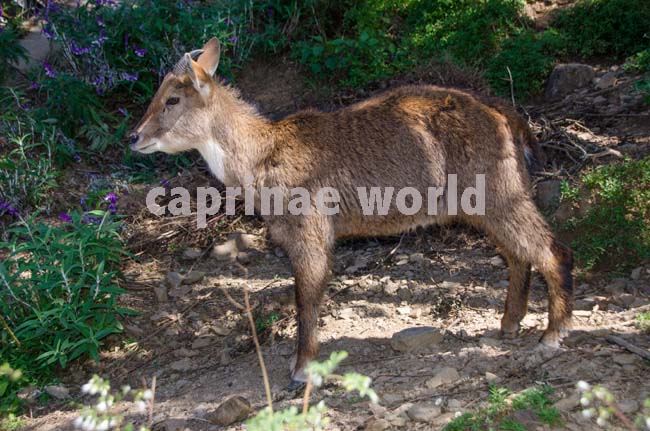
Male Himalayan Gray Goral in winter coat at Nainital Zoo, Uttarakhand, India – around 280 kilometers southeast of Kufri. Note some of the identification features for the Himalayan Gray Goral: dark stripes on thoracic limbs from radiocarpal joints down to the fetlocks; dark stripe on the plantar area of pelvic limbs merely as a segment; white chin [8]. Photo: Ralf Bürglin
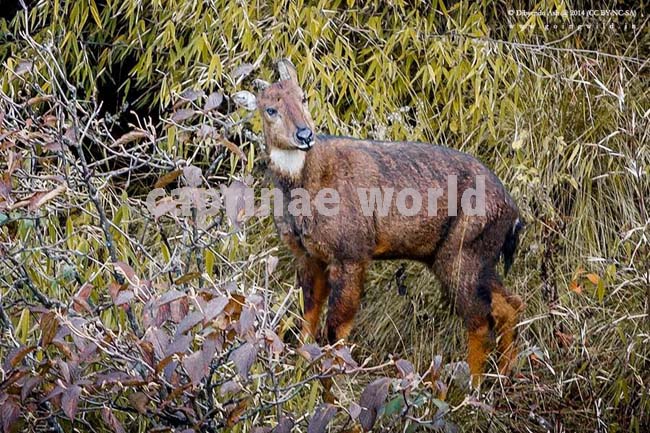
Male Himalayan Brown Goral at Pangolakha Wildlife Sanctuary, East Sikkim – about 920 kilometers southeast of Nainital. Note some of the identification features for the Himalayan Brown Goral: dark stripe on the dorsal area of thoracic limbs in segments; dark stripe on the plantar area of pelvic limbs (often extends all the way from thighs to fetlocks) always more dominant; tail: all black. [8] Photo: Dibyendu Ash
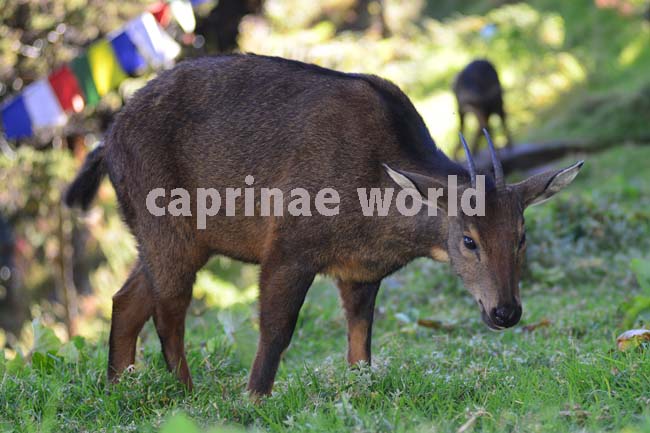
Female Himalayan Brown Goral in winter coat (November), Cheri Monastery, Bhuthan – 95 kilometers northeast of Pangolakha Wildlife Sanctuary. Note some of the identification features for the Himalayan Brown Goral: winter coat dark brown to black; dark nasal stripe absent; white patch at the base of auricle absent; dark nuchal and dorsal stripe prominent [8]. Photo: Ralf Bürglin
Horns
Both sexes in Himalayan goral have short, pointed slightly curving horns 13 to 18 cm long. The horns show small, irregular serregations. The horns of the Brown Himalayan Goral are straighter and less heavily serrated than those of the gray form. Furthermore the Himalayan Brown Goral appears to have on average somewhat shorter horns, although an exeptional specimen from Bhutan had a horn length of 18,7 cm. [1]
Habitat
Both Himalayan goral species are said to occur in similar habitat types. [3] But there are differences. Himalayan Gray Goral in Pakistan occur in plant communities, including scattered pine and thorny shrub habitats, whereas the Himalayan Brown Goral live in wooded mountains with a fairly dense cover [3]. Hence consequences regarding the ecology of the two goral species are obvious.
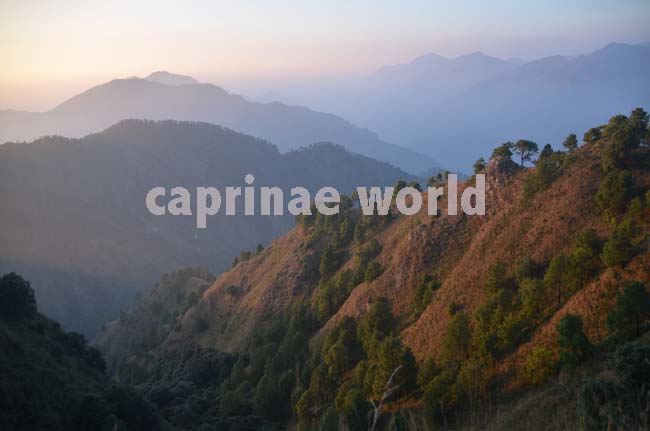
Different types of Himalayan Goral habitat: semi open, subalpine coniferous forest at Majathal Sanctuary, Himachal Pradesh …
Food and feeding
Over 90 percent of winter and summer diet of the Himalayan Brown Goral is grass, whereas the annual diet of Himalayan Grey Goral consists only of 63 percent grass. [3] The difference could be due to climatic reasons and the abundance of grass.
Breeding
Territoriality: Male Himalayan Gray Gorals are no doubt territorial like the Himalayan Brown Goral. [3]
Mating: Himalayan Brown Gorals mate in October-November, Himalayan Gray Gorals in November-December. [3]
Sexual maturity: Himalayan Brown Gorals reach sexual maturity in 3 years [5], Himalayan Gray Gorals in 2-3 years [3].
Gestation: in both species about 180 days [3]
Parturition: from April to May [3] in both species
Young per birth: single offspring are the norm, twinning is rare in both species [3]
Conservation status / threats
There is no estimate of the total population size. In India and Nepal the Himalayan Brown Goral seems to occur in relatively good numbers, but in China numbers of this species are thought to be small. It appears that more than 1000 individuals of the Himalayan Gray Goral live in Pakistan, extending into adjacent areas in India. [1] Both species are classified as Near Threatend on the IUCN Red List. Illegal subsistence hunting, habitat destruction and fragmentation are major threats to the Himalayan Brown Goral. [3] In China, poaching is probably the main threat, however poaching in Tibet is thought to be limited due to prevailing religious beliefs. [1] On the other hand in Pakistan the „natural attachment with guns“ of the islamic local people „plays a great role to deteriorate the wildlife“. [7] In the Himalayan Gray Goral many populations are small and fragmented. Widespread habitat alteration and disturbance, primarily illegal hunting and livestock grazing, are major threats. [3]
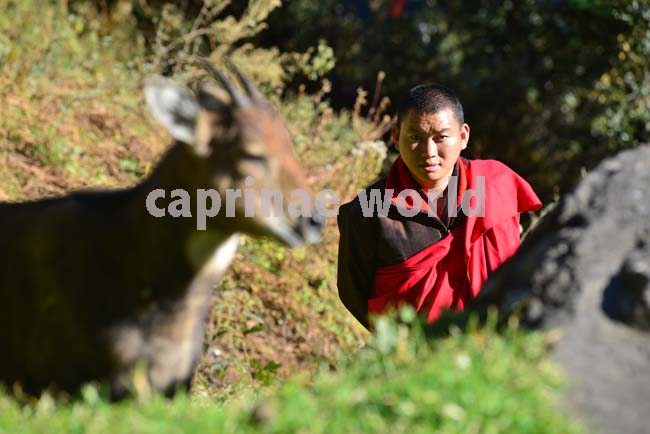
A Bhutanese Monk watching goral: Poaching in Tibet is thought to be limited due to prevailing religious beliefs. The same is presumably true for Bhutan. Photo: Ralf Bürglin
Literature Cited
[1] Damm, Gerhard R. and Franco, Nicolás, 2014: The CIC Caprinae Atlas of the World – CIC International Council for Game and Wildlife Conservation, Budakeszi, Hungary in cooperation with Rowland Ward Publications RSA (Pty) Ltd., Johannesburg, South Africa.
[2] Duckworth, J.W. & MacKinnon, J. 2008. Naemorhedus goral. The IUCN Red List of Threatened Species 2008: e.T14296A4430073. http://dx.doi.org/10.2305/IUCN.UK.2008.RLTS.T14296A4430073.en. Downloaded on 16 January 2017.
[3] Wilson, D.E. and Mittermeier, R.A. [eds], 2011: Handbook of the Mammals of the World. Vol. 2. Hoofed Mammals. Lynx Edicions, Barcelona.
[4] Groves, Colin and Grubb, Peter, 2011: Ungulate Taxonomy. The John Hopkins University Press.
[5] Castelló, José R., 2016: Bovids of the World – Antelopes, Gazelles, Cattle, Goats, Sheep, and Relatives. Princton University Press.
[6] https://skepticalscience.com/In_Search_Of_Himalayan_Ice_Loss.html
[7] Perveen, Farzana; Anzela Khan, and Adnan Hussain Shah: „Hunting and Trapping Pressures on the Himalayan Goral, Naemorhedus Goral (Hardwicke) (Artiodactyla: Bovidae) in Kohistan, Pakistan.“ American Journal of Zoological Research 1, no. 1 (2013): 5-11.
[8] Hrabina, Petr: „A new insight into the taxonomy and zoogeography of recent species of goral (Nemorhaedus, Bovidae, Ruminantia)„, Gazella 42, 2015, Zoo Praha

